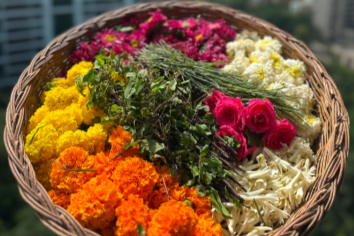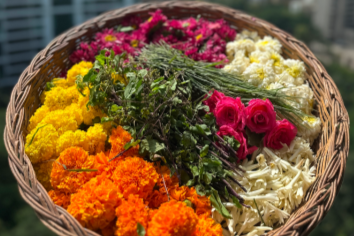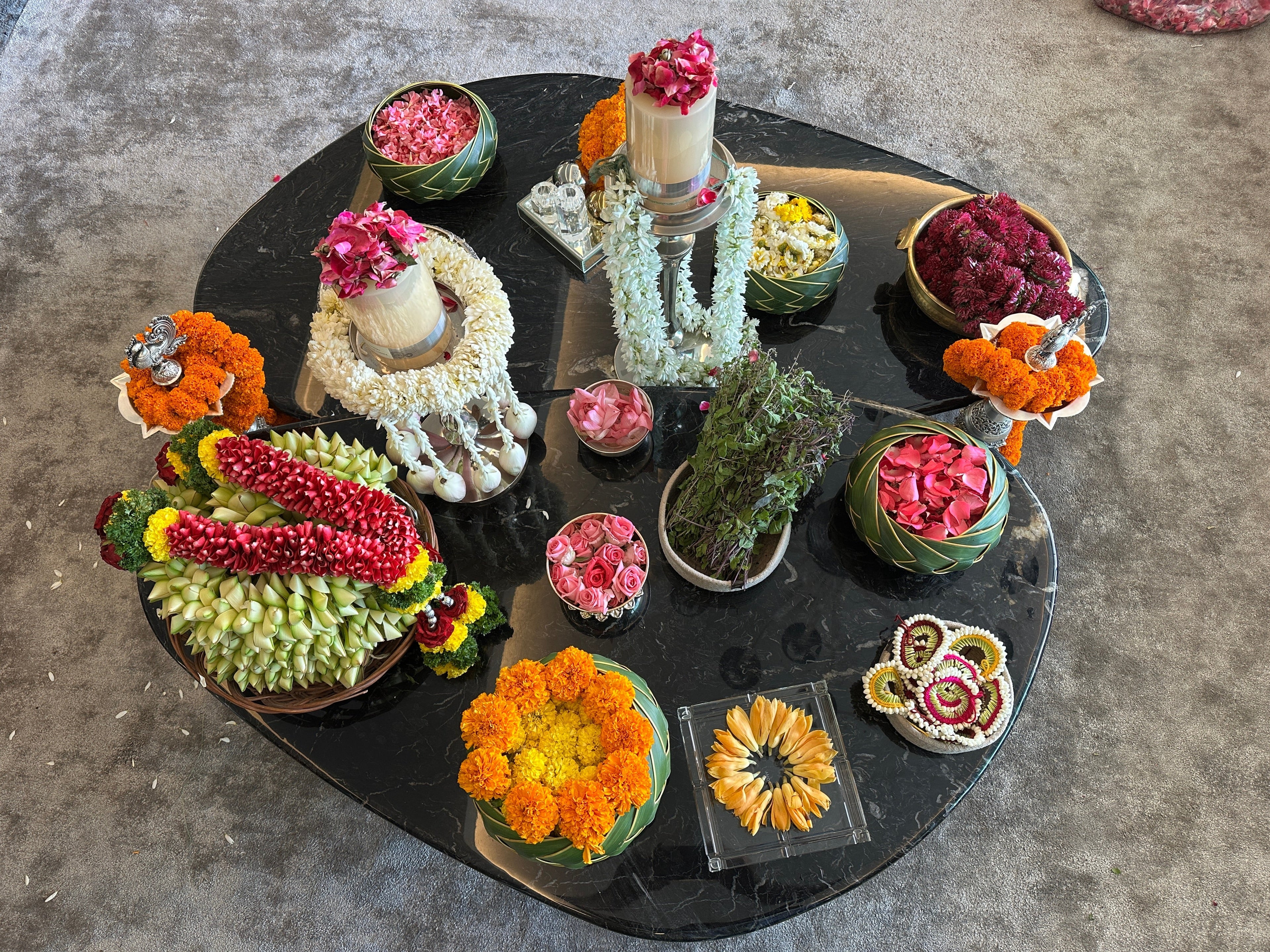
Finding truly fresh flowers in Pune can make all the difference in your pooja rituals and home décor. But let's be honest—navigating the city's flower markets at dawn isn't everyone's cup of tea. I've spent countless early mornings hunting for the perfect marigolds and roses, only to find wilted blooms or exhausted vendors by the time I arrived. (Those 5 AM alarms can be brutal, especially during monsoon season!)
This comprehensive guide will take you through every avenue for sourcing the freshest flowers in Pune—from traditional markets to modern subscription services—helping you make informed choices that align with both your spiritual needs and practical lifestyle.
Key Takeaways
-
The freshest flowers in Pune are available between 4-7 AM at wholesale markets, with quality declining rapidly afterward
-
Temperature and handling significantly impact flower longevity—look for vendors using proper storage techniques
-
Modern delivery services now offer farm-direct options that bypass traditional markets entirely
-
Subscription services provide convenience and consistent quality for daily pooja needs
-
Several insider techniques can help you identify genuinely fresh blooms when shopping
Traditional Markets: Pune's Floral Heartbeat
Gultekdi Market: The Wholesale Hub
The Gultekdi Flower Market (now relocated to Market Yard) stands as Pune's primary wholesale flower destination. Operating between 4 AM and 11 AM daily, this bustling market serves as the central distribution point for flowers arriving from farms surrounding the city. Here, vendors offer everything from marigolds and roses to more exotic varieties like orchids and anthuriums.
But timing is everything. If you're serious about getting fresh flowers in Pune, you need to arrive before 7 AM when the premium stock is still available. By 9 AM, many of the best blooms have been claimed by retailers and event decorators, leaving fewer options for individual buyers.
Key advantages of shopping at Gultekdi include:
-
Competitive wholesale pricing (marigolds: ₹80-120/kg; roses: ₹150-250/kg)
-
Greatest variety in a single location
-
Direct interaction with experienced vendors
The market's digital auction system for bulk purchases ensures fair pricing, though it's primarily designed for commercial buyers rather than individuals seeking daily pooja flowers.
Neighborhood Flower Stands: Convenience vs. Freshness
Scattered throughout Pune's neighborhoods, local flower stands offer more accessible options for daily purchases. These small vendors typically source their inventory from the wholesale markets early each morning, setting up shop around 7 AM in residential areas and near temples.
Popular locations include:
-
Camp Area: Flower vendors near Pune Camp offer varied selection for mixed religious communities
-
Deccan Gymkhana: Small but reliable vendors cater to traditional Pune families
-
Kothrud: Several stands near temples specialize in pooja-specific varieties
-
Viman Nagar: Newer vendors catering to modern apartment complexes
While convenient, these stands present a freshness gamble. Without refrigeration, flowers begin wilting by mid-morning, especially during summer months. Your best strategy is to develop a relationship with a specific vendor who will set aside premium blooms for regular customers.
Temple-Adjacent Vendors: Ritual-Ready Options
Flower sellers positioned near major temples offer another traditional option, with inventories specifically curated for religious purposes. These vendors understand ritual requirements and typically stock appropriate varieties for different deities.
Prominent locations include:
-
Dagdusheth Halwai Ganpati Temple: Vendors specializing in red hibiscus and yellow marigolds
-
Pataleshwar Cave Temple: Sellers offering lotus and champak flowers
-
ISKCON Temple: Vendors with tulsi plants and devotional garlands
These sellers often include additional pooja items alongside flowers, creating convenient one-stop shopping for devotees. However, prices typically run 20-30% higher than wholesale markets due to the premium location and specialized knowledge.
Modern Alternatives: Beyond Traditional Markets
Farm-Direct Programs: Cutting Out Middlemen
An emerging trend in Pune's flower scene is farm-direct sourcing that connects consumers directly with flower farms in surrounding regions like Talegaon, Chakan, and the Western Ghats. These programs eliminate multiple handling stages that compromise freshness, delivering blooms that last significantly longer.
Some operate through pre-order systems where customers:
-
Place orders 1-2 days in advance
-
Select specific varieties and quantities
-
Receive flowers harvested within 24 hours of delivery
This approach yields notably fresher flowers with stronger fragrances and extended vase life, particularly beneficial for special occasions and home décor purposes. For daily pooja needs, however, the pre-planning requirement can be cumbersome.
Subscription Services: The Modern Solution for Daily Needs
For those seeking both freshness and convenience, flower subscription services represent the ideal modern solution for getting fresh flowers delivered in Pune. These services operate on a simple premise: regular deliveries of seasonally appropriate, farm-fresh flowers brought directly to your doorstep before morning pooja time.
How subscription services transform the flower buying experience:
-
Consistent Quality: Subscribers receive premium-grade blooms selected by experts
-
Morning Delivery: Flowers arrive by 6-7 AM, perfect for traditional morning rituals
-
Customization: Options to specify deity-appropriate varieties and quantities
-
Sustainability: Reduced waste through planned harvesting and minimal packaging
-
Time Savings: Eliminate daily market trips while enjoying superior freshness
For more insights on why flower subscriptions are revolutionizing traditional practices, explore our detailed analysis of Why Smart Buyers Are Choosing Flower Subscriptions.
Technology-Enabled Freshness: How Modern Services Maintain Quality
The most sophisticated flower delivery services in Pune now implement temperature-controlled supply chains that dramatically extend bloom longevity. Unlike traditional markets where flowers sit in ambient temperatures (often exceeding 30°C during summer), modern services maintain optimal conditions throughout the journey.
Key technology innovations include:
-
Cold-chain logistics maintaining 12-15°C during transport
-
Hydration solutions that prevent premature wilting
-
Careful handling protocols that minimize physical damage
-
Quality control checkpoints ensuring only premium blooms reach customers
These advancements mean subscribers receive flowers that not only look fresher but maintain their spiritual potency longer—crucial for devotional practices that depend on the energy of truly fresh blooms.
Pro Tips: How to Identify Truly Fresh Flowers
Visual Freshness Indicators
When evaluating flower freshness, look for these visual cues:
-
Petals: Should be firm, vibrant, and unblemished without brown edges
-
Stems: Fresh cuts show moist, green interiors rather than dried or discolored tissue
-
Buds: Partially closed buds indicate freshness and longer remaining life
-
Leaves: Crisp, green foliage without yellowing or wilting
-
Color: Vivid rather than faded tones, particularly in red and purple flowers
For marigolds specifically (a pooja staple), gently squeeze a few petals—truly fresh ones will feel firm and springy rather than soft or mushy.
Fragrance Assessment
The aroma profile offers powerful clues about flower freshness:
-
Jasmine: Should present an intense, sweet fragrance that's detectable from several inches away
-
Roses: Fresh roses offer a subtle, sweet scent that strengthens when gently blown upon
-
Marigolds: Possess a distinctive earthy aroma that weakens as flowers age
-
Lotus: Fresh blooms have a delicate, sweet fragrance that dissipates quickly with age
If flowers advertised as "fresh" lack their characteristic scent, they've likely been stored for too long or improperly handled.
Stem Inspection Techniques
Professional florists use these stem evaluation methods to verify freshness:
-
Snap Test: Bend the stem slightly—fresh stems snap crisply while older stems bend flexibly
-
Cut Examination: Fresh cuts show clear, moist surfaces; aged cuts appear dry or discolored
-
Sap Check: Squeeze stems near the cut—fresh flowers release milky sap while older ones remain dry
-
Water Clarity: In display buckets, clear water indicates fresh stock; cloudy water suggests aging blooms
These simple assessments take seconds but can dramatically improve your purchasing decisions.
Sourcing Calendar: Seasonal Availability in Pune
Summer Blooms (March-June)
Pune's hot, dry summers favor heat-resistant varieties:
-
Marigolds: Peak production with vibrant colors and sturdy blooms
-
Roses: Local varieties thrive, though with smaller bloom size
-
Jasmine: Abundant and fragrant, perfect for evening rituals
-
Gerbera: Greenhouse-grown varieties available year-round
-
Zendu: Traditional yellow marigold variant at its best quality
During these months, early morning purchasing becomes even more critical as flowers deteriorate rapidly in the heat.
Monsoon Offerings (July-September)
The rainy season brings challenges and opportunities:
-
Chrysanthemums: Begin appearing in white and yellow varieties
-
Marigolds: Continue but with more variable quality due to rain damage
-
Tuberoses: Reach peak fragrance during this humid period
-
Lotus: Local lotus production increases in natural water bodies
-
Champa: These fragrant blooms thrive in monsoon conditions
Monsoon flowers often carry higher prices due to cultivation challenges, but their symbolic connection to the season holds special significance in certain rituals.
Winter Selection (October-February)
Pune's mild winters bring the year's greatest variety:
-
Chrysanthemums: Peak season with multiple colors and varieties
-
Roses: Highest quality with larger blooms and vibrant colors
-
Marigolds: Consistent production with excellent quality
-
Orchids: More readily available from specialized growers
-
Carnations: Seasonal availability increases
Winter offers the widest selection and longest-lasting blooms, making it ideal for special celebrations and elaborate arrangements.
For deeper insights into choosing seasonally appropriate flowers for ritual purposes, see our detailed guide on Fresh Flowers Decoded: The Complete Ecosystem from Farm to Spiritual Significance.
Cultural Context: Pune's Unique Floral Traditions
Temple Traditions and Local Preferences
Pune's flower markets reflect the city's distinctive spiritual heritage, with certain varieties holding special significance:
-
Red Hibiscus: Essential for Ganesh worshippers, particularly at the famous Dagdusheth Temple
-
Yellow Champa: Traditional offering at many Maharashtrian household shrines
-
Mogra (Jasmine): Woven into hair by women during special ceremonies and festivals
-
Zendu (Marigold): Used extensively for Ganapati decorations during the city's famous festival
Local vendors understand these traditions intimately, often preparing deity-specific bundles during major festivals and celebration days.
Ethical Sourcing Considerations
As awareness grows about the environmental impact of cut flowers, many Pune residents are seeking more sustainable options. For insights into the environmental considerations of flower sourcing, read our in-depth exploration of The Cut Flower Industry's Dirty Secret & Why Local, Farm-Fresh Flowers Are the Future.
When purchasing flowers, consider these ethical factors:
-
Transportation distance (closer farms mean fresher flowers and lower carbon footprint)
-
Growing practices (traditional farms often use fewer chemicals than industrial operations)
-
Labor conditions (smaller operations typically provide better working environments)
-
Packaging (minimal or biodegradable options reduce environmental impact)
Many devotees find that addressing these considerations enhances rather than detracts from the spiritual significance of their floral offerings.
FAQ: Common Questions About Finding Fresh Flowers in Pune
What's the best time to buy flowers at Gultekdi Market?
For wholesale quality and selection, arrive between 4:30-6:00 AM when fresh shipments are being unloaded. By 7:00 AM, commercial buyers have claimed the premium stock, and by 9:00 AM, much of what remains has been sitting in ambient temperatures for hours, compromising freshness.
How can I tell if marigolds are truly fresh?
Fresh marigolds display vibrant, uniform color without browning at the petal edges. The flower head feels firm when gently squeezed, and the stems appear green and moist rather than woody. Additionally, fresh marigolds retain their distinctive earthy aroma, which fades noticeably as the flowers age.
Are flowers from local neighborhood vendors fresh enough for pooja?
It depends entirely on the vendor's sourcing practices and turnover rate. Some neighborhood vendors receive fresh stock daily and maintain proper storage conditions, while others keep flowers for multiple days. Your best approach is to ask directly when their flowers were harvested and observe how they store their inventory.
How do flower subscriptions work for daily pooja needs?
Pooja flower subscriptions typically offer:
-
Daily morning delivery (usually between 6:00-7:30 AM)
-
Set quantities of traditional varieties appropriate for rituals
-
Flexible subscription periods (1, 3, or 6 months commonly available)
-
Options to pause during travel periods
-
Seasonal adjustments that reflect availability and traditional usage
For more details on subscription options, see our comprehensive guide on Why Smart Buyers Are Choosing Flower Subscriptions.
What flowers should I look for during specific Pune festivals?
-
Ganesh Chaturthi: Red hibiscus, yellow and orange marigolds, durva grass
-
Diwali: Chrysanthemums, marigolds, roses in red and orange tones
-
Gudi Padwa: Mango leaves and neem flowers
-
Navratri: Red roses, lotus, and hibiscus for goddess worship
Local vendors typically stock festival-specific varieties in advance, though pre-ordering ensures availability during peak demand periods.
How can I keep my flowers fresh after purchase?
For essential tips on maintaining flower freshness after purchase, explore our detailed guidance on proper handling and storage in Pooja Flowers: Why Only Fresh Blooms Matter & What NOT to Offer.
Is it worth paying extra for farm-direct flowers?
For daily pooja purposes, the quality difference between farm-direct flowers and those from early-morning market visits is minimal if you're purchasing at optimal times. However, farm-direct options typically offer significantly longer vase life (2-3 additional days), making them worthwhile for home décor or special ceremonies where longevity matters.
Conclusion: Finding Your Ideal Fresh Flower Source
Sourcing genuinely fresh flowers in Pune requires balancing three key factors: quality, convenience, and consistency. While traditional markets offer the romance of hands-on selection and cultural immersion, they demand significant time investment and early rising. Neighborhood vendors provide accessibility but variable quality, while modern subscription services deliver convenience and consistency for busy devotees.
The ideal approach often combines these options—perhaps a subscription for daily essentials supplemented with special market visits during festivals or significant ceremonies. This balanced strategy ensures you always have access to fresh flowers for pooja while maintaining the meaningful connection to tradition that these beautiful offerings represent.
Whichever path you choose, understanding the indicators of true freshness empowers you to make informed decisions, enhancing both the aesthetic beauty and spiritual efficacy of your floral offerings.
For deeper insights into the spiritual significance of fresh flowers and their role in devotional practices, explore our comprehensive guide on Fresh Flowers Decoded: The Complete Ecosystem from Farm to Spiritual Significance.

